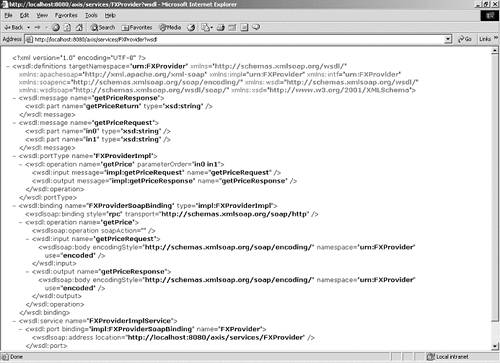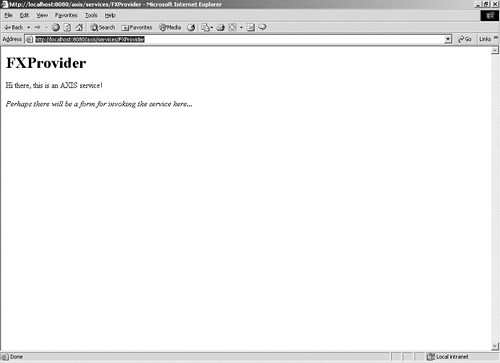9.4. Paper and Pencil
9.4.1. Objective
Apache Axis is a next-generation SOAP engine. This exercise is meant to have you practice using Apache Axis to expose an existing interface as a Web Service.
Apache Axis has a different architecture design from previous versions of Apache SOAP. It can generate SOAP client and server components directly, without using a third-party developer IDE/workbench tool.
9.4.2. Exercise
Using the Foreign Exchange Spot Rate Quote example in Chapter 8, Web Services in Action Case Study, you are to expose the interface as a Web Service using Apache Axis's utilities java2wsdl and wsdl2java.
The source code files FXProviderIF.java and FXProviderImpl.java can be found on the CD-ROM accompanying this book under /labs/ch9. They are also listed here for reference (refer to the following excerpts in Figures 9-6 through 9-16).
Figure 9-16. Verifying Web Services Deployment by Checking the WSDL

Procedures to Create a Web Service Using Apache Axis
Step 1: Define Web Services Interfaces
First, define the interfaces (that is, methods or APIs) you want to expose as Web Services. Refer to the excerpt FXProviderIF.java in Figure 9-5. A new procedure, getPrice, is added under the public interface FXProviderIF. The getPrice procedure takes in two input parameters sellCurrency and buyCurrency and returns the price in a string format.
Figure 9-5. Start by Defining the Interface First (FXProviderIF.java)
package myAxis; import java.rmi.Remote; import java.rmi.RemoteException; public interface FXProviderIF extends Remote { public String getPrice(String sellCurrency, String buyCurrency) throws RemoteException; } |
Step 2: Define Web Services Implementation
Then, define the business logic for the interface to be exposed as Web Services. This may be implemented by developing custom-built code or invoking remote procedure calls from back-office systems (such as a mainframe). Figure 9-6 shows an example of how to implement the Web Services business logic in the program FXProviderImpl. java. The getPrice procedure is now expanded to incorporate the price quote for the currency pairs HKD-USD, HKD-EUR, HKD-RMB, HKD-SGD, HKD-MYR, and so forth. In this example, the same business logic used in the exercise in Chapter 3, Web Services Technology Overview, is reused for instructional purposes.
Figure 9-6. Defining the Business Logic to Implement the Web Service (FXProviderImpl.java)
package myAxis; import java.math.BigDecimal; import java.util.*; public class FXProviderImpl implements FXProviderIF { // FX conversion rate public String getPrice(String sellCurrency, String buyCurrency) { if (sellCurrency.equalsIgnoreCase("HKD")) { if (buyCurrency.equalsIgnoreCase("USD")) { return "0.128"; } else if (buyCurrency.equalsIgnoreCase("EUR")) { return "0.123"; } else if (buyCurrency.equalsIgnoreCase("RMB")) { return "1.25"; } else if (buyCurrency.equalsIgnoreCase("SGD")) { return "0.22"; } else if (buyCurrency.equalsIgnoreCase("MYR")) { return "2.85"; } else return "0.00"; } else if (sellCurrency.equalsIgnoreCase("USD")) { if (buyCurrency.equalsIgnoreCase("HKD")) { return "7.78"; } else if (buyCurrency.equalsIgnoreCase("EUR")) { return "0.92"; } else if (buyCurrency.equalsIgnoreCase("RMB")) { return "8.20"; } else if (buyCurrency.equalsIgnoreCase("SGD")) { return "2.5"; } else if (buyCurrency.equalsIgnoreCase("MYR")) { return "3.45"; } else return "0.00"; } else return "0.00"; // end-if } // getPrice } // class |
Step 3: Prepare for Stub/Skeleton Generation
Compile the source code to Java classes to prepare stub (client module) and skeleton (server module) generation. Figure 9-7 shows the command javac to compile the Java code.
Figure 9-7. Prepare for Stub/Skeleton Generation
D:DevmydemomyAxis>javac FX*.java
D:DevmydemomyAxis>dir
Volume in drive D is WIN2K
Volume Serial Number is 3D2F-1863
Directory of D:DevmydemomyAxis
09/22/2002 03:16p <DIR> .
09/22/2002 03:16p <DIR> ..
09/22/2002 03:19p 1,761 FXProviderImpl.java
09/22/2002 03:18p 394 FXProviderIF.java
09/24/2002 12:13a 266 FXProviderIF.class
09/24/2002 12:13a 827 FXProviderImpl.class
10 File(s) 12,736 bytes
3 Dir(s) 9,780,002,816 bytes free
|
Step 4: Create WSDL
Generate a Web Services Description Language (WSDL) from the interface files (Java classes are required) created in the previous steps. The utility org.apache. axis.wsdl.Java2WSDL will generate the WSDL called FXProvider.wsdl in the same directory, with the Universal Resource Name (URN, or namespace) FXProvider and the service end-point http://localhost:8080/axis/FXProvider, provided with the implementation file FXProviderImpl.class. In Figure 9-8, the utility Java2WSDL will generate a WSDL FXProvider.wsdl that specifies the service end-point URL http://localhost:8080/axis/FXProvider, the URN FXProvider based on the interface file FXProviderImpl. java. The Java2WSDL utility requires the implementation file to be precompiled first.
Figure 9-8. Creating WSDL
D:DevmydemomyAxis>java org.apache.axis.wsdl.Java2WSDL -o FXProvider.wsdl -l" http://localhost:8080/axis/FXProvider" -n "urn:FXProvider" -p"myAxis" "urn:FXProvider" |
In the WSDL generated (shown in Figure 9-9), the business service (“operation name” or the method exposed), service end-point (“address location”), input parameters (“in0” and “in1” of the incoming message name “getPriceRequest”), and output parameter (“getPriceReturn”) are highlighted for easy reference. These are the key elements to be specified in writing a Web Services client. Refer to the exercise in Chapter 3, Web Services Technology Overview, for more details.
Figure 9-9. Generating WSDL Using Apache Axis Utility
<?xml version="1.0" encoding="UTF-8"?> <wsdl:definitions targetNamespace="urn:FXProvider" xmlns="http://schemas.xmlsoap.org/wsdl |
Step 5: Generate Stub/Skeleton
The next step is to generate the club stubs and the server skeletons in order to expose the implementation Java classes as Web Services. Figure 9-10 shows the command WSDL2Java that generates both the SOAP stub (client-side component) and skeleton (server-side component). Both the stubs and the skeletons will provide a proxy for the Web Services using SOAP messaging. The following command WSDL2Java in Figure 9-10 will generate the client stubs and the server skeletons under a subdirectory "myAxis" based on the specified WSDL (FXProvider.wsdl) and the namespace ("urn:FXProvider"). This step will also generate the Web Services Deployment Descriptors (WSDD) for deployment and undeployment. These descriptors are similar to J2EE deployment descriptors and contain deployment-related information (such as service end-points and input and output parameters). Refer to Figure 9-11 for an example.
Figure 9-10. Generating Client Stubs and Server Skeletons
D:DevmydemomyAxis>java org.apache.axis.wsdl.WSDL2Java -s -d Session -Nurn:FXProvider
|
Figure 9-11 shows a Web Services Deployment Descriptor (WSDD). In the WSDD file, it contains some deployment information, including the namespace, port name, and class name. This is slightly different from a normal deployment descriptor and includes some WSL information. It is proprietary and cannot be used by other SOAP engines.
Figure 9-11. Web Services Deployment Descriptor Will Be Created During Stubs/Skeletons Generation
<deployment
xmlns="http://xml.apache.org/axis/wsdd/"
xmlns:java="http://xml.apache.org/axis/wsdd/providers/java">
<!— Services from FXProviderImplService WSDL service —>
<service name="FXProvider" provider="java:RPC">
<parameter name="wsdlTargetNamespace" value="urn:FXProvider"/>
<parameter name="wsdlServiceElement" value="FXProviderImplService"/>
<parameter name="wsdlServicePort" value="FXProvider"/>
<parameter name="className" value="myAxis.FXProviderSoapBindingImpl"/>
<parameter name="wsdlPortType" value="FXProviderImpl"/>
<operation name="getPrice" qname="operNS:getPrice" xmlns:operNS="urn:FXProvider"
|
Step 6: Compile Stub/Skeleton into Java Classes
The client stubs and the server skeletons need to be compiled into Java classes, as shown in Figure 9-12.
Figure 9-12. Compiling the Client Stubs and the Server Skeletons
D:DevmydemomyAxis>cd myAxis D:DevmydemomyAxismyAxis>javac *.java |
Step 7: Prepare for Deployment
To prepare for Web Services deployment, copy the compiled classes into the Web Container's Axis class directory (see Figure 9-13). In this demo environment, Apache Axis can be found under the subdirectory myAxis of the Apache Axis class directory %JWSDP_HOME%axisweb-infclasses.
Figure 9-13. Preparing for Deployment by Copying the Classes to Web Container
D:DevmydemomyAxismyAxis>copy *.class d:devwsdpwebappsaxisweb-infclassesmyAxis
|
Step 8: Deploy Web Services
To start the implementation, deploy the Web Services Deployment Descriptor (WSDD) generated earlier, as shown in Figure 9-14. The AdminClient will deploy the Web Services and the associated proxy and Java classes to the SOAP server run-time environment.
Figure 9-14. Deploying Web Services With WSDD
D:DevmydemomyAxismyAxis>java org.apache.axis.client.AdminClient deploy.wsdd
- Processing file deploy.wsdd
- <Admin>Done processing</Admin>
|
Step 9: Verify Web Services Deployed
Upon successful deployment, you can verify the Web Services deployment by entering either one of the following URLs. The first URL http://localhost:8080/axis/services/FXProvider should confirm the service is deployed using the Axis engine (see Figure 9-15). The second URL http://localhost:8080/axis/services/FXProvider?WSDL should return a WSDL that is identical to the WSDL generated in earlier steps (see Figure 9-16). This also confirms that the Web Service FX Provider is deployed and appropriate Java classes are deployed under the Axis class directory.
Figure 9-15. Verifying Web Services by Checking the Service End-Point URL

Concluding Remarks
Apache Axis has the capability to generate stubs (client modules) and skeletons (server modules) that is comparable to Java Web Service Developer Pack (JWSDP)'s wscompile. It does, however, have different design objectives and usage than JWSDP. It has a wider range of functionality to be the next generation of SOAP engines. Thus, both products complement each other in developing and implementing Web Services solutions.
It is amazing to see how these Open Sources and publicly available tools evolve speedily to support the next frontiers of Web Services technology.
9.4.3. References
Grid Computing
Global Grid Forum. http://www.gridforum.org/ogsi-wg/drafts/draft-ggf-ogsi-gridservice-23_2003-02-17.pdf
The Globus Project. http://www.globus.org/research/papers.html#OverviewPapers
The Securities Industry Middleware Council. “The Future of Middleware: Grid Computing and Web Services.” November 19, 2002, General Meeting. http://www.simc-inc.org/archive0203/Grid/agenda19nov2002.htm
Tom Sullivan . “Sun Combines Grid Computing, Web services.” http://www.infoworld.com/article/02/02/15/020215hnsunonegrid_1.html
Liang-Jie Zhang, Jen-Yao Chung, and Qun Zhou . “Developing Grid Computing Applications, Part 1.” http://www-106.ibm.com/developerworks/webservices/library/ws-grid1/
Liang-Jie Zhang, Jen-Yao Chung, and Qun Zhou . “Developing Grid Computing Applications, Part 2.” http://www-106.ibm.com/developerworks/webservices/library/ws-grid2/
369The Next Frontiers 369 References Bibliography Apache Axis [ch09biblio01div01entry01] Apache Axis official Web site http //ws apache org/axis/index html Grid Computing [ch09biblio01div02entry01] Global Grid Forum http //www gridforum org/ogsi wg/drafts/draft ggf ogsi gridservice 23_2003 02 17 pdf pers html#OverviewPapers [ch09biblio01div02entry02] The Globus Project http //www globus org/research/pa [ch09biblio01div02entry03] The Securities Industry Middleware Council " The Future of Middleware Grid Computing and Web Services " November 19 2002 General Meeting http // www simc inc org/archive0203/Grid/agenda19nov2002 htm [ch09biblio01div02entry04] Tom Sullivan " Sun Combines Grid Computing Web services " http // www infoworld com/article/02/02/15/020215hnsunonegrid_1 html [ch09biblio01div02entry05] Liang Jie Zhang Jen Yao Chung and Qun Zhou " Developing Grid Computing Applications Part 1 " http //www 106 ibm com/developerworks/webservices/li brary/ws grid1/ [ch09biblio01div02entry06] Liang Jie Zhang Jen Yao Chung and Qun Zhou " Developing Grid Computing Applications Part 2 " http //www 106 ibm com/developerworks/webservices/li brary/ws grid2/
JXTA
Max Goff . “Jini, JXTA and Web Services: a Comparison of Network/Distributed Computing Approaches.” http://developer.java.sun.com/developer/onlineTraining/webcasts/20plus/pdf/mgoff.pdf
JXTA Bridge (a tool to allow SOAP messaging over a JXTA peer-to-peer network. http://relativity.yi.org/jxta-bridge/
Articles that discuss and compare JXTA with Web Services.
http://www.openp2p.com/pub/a/p2p/2001/07/20/convergence.html
http://www.croftsoft.com/library/tutorials/jxta/
N1
Yousef A. Khalidi . “N1 Architecture.” SunNetwork Conference 2002.
Paul Strong . “N1 System.” SunNetwork Conference 2002.
Sun's N1 official website. http://wwws.sun.com/software/solutions/n1/
Web Services Management Tools
Actional. http://www.actional.com/
Adjoin. http://www.adjoin.com/
Amberpoint. http://www.amberpoint.com/
Confluent. http://www.confluentsoftware.com/
Empirix. http://www.empirix.com/
Flamenco Network. http://www.flamenconetwork.com/
IBM alphaWorks has several niche technologies that can be used as Web Services management tools. http://alphaworks.ibm.com or http://alphaworks.ibm.com/tech/wsgw/
Iopsis. http://www.iopsis.com/
Systinet. http://www.systinet.com/
Talking Blocks. http://www.talkingblocks.com/
WestBridge Technology. http://www.westbridgetech.com
370The Next Frontiers 370 JXTA [ch09biblio01div03entry01] Max Goff " Jini JXTA and Web Services a Comparison of Network/ Distributed Computing Approaches " http //developer java sun com/developer/onlineTrain ing/webcasts/20plus/pdf/mgoff pdf [ch09biblio01div03entry02] JXTA Bridge a tool to allow SOAP messaging over a JXTA peer to peer network http //relativity yi org/jxta bridge/ [ch09biblio01div03entry03] Articles that discuss and compare JXTA with Web Services http // www openp2p com/pub/a/p2p/2001/07/20/convergence html http //www croftsoft com/li brary/tutorials/jxta/ N1 [ch09biblio01div04entry01] Yousef A Khalidi " N1 Architecture " SunNetwork Conference 2002 [ch09biblio01div04entry02] Paul Strong " N1 System " SunNetwork Conference 2002 [ch09biblio01div04entry03] Sun s N1 official website http //wwws sun com/software/solutions/n1/ Web Services Management Tools [ch09biblio01div05entry01] Actional http //www actional com/ [ch09biblio01div05entry02] Adjoin http //www adjoin com/ [ch09biblio01div05entry03] Amberpoint http //www amberpoint com/ [ch09biblio01div05entry04] Confluent http //www confluentsoftware com/ [ch09biblio01div05entry05] Empirix http //www empirix com/ [ch09biblio01div05entry06] Flamenco Network http //www flamenconetwork com/
371The Next Frontiers 371 [ch09biblio01div05entry07] IBM alphaWorks has several niche technologies that can be used as Web Services management tools http //alphaworks ibm com or http //alphaworks ibm com/ tech/wsgw/ [ch09biblio01div05entry09] Iopsis http //www iopsis com/ [ch09biblio01div05entry10] Systinet http //www systinet com/ [ch09biblio01div05entry11] Talking Blocks http //www talkingblocks com/ [ch09biblio01div05entry12] WestBridge Technology http //www westbridgetech com
